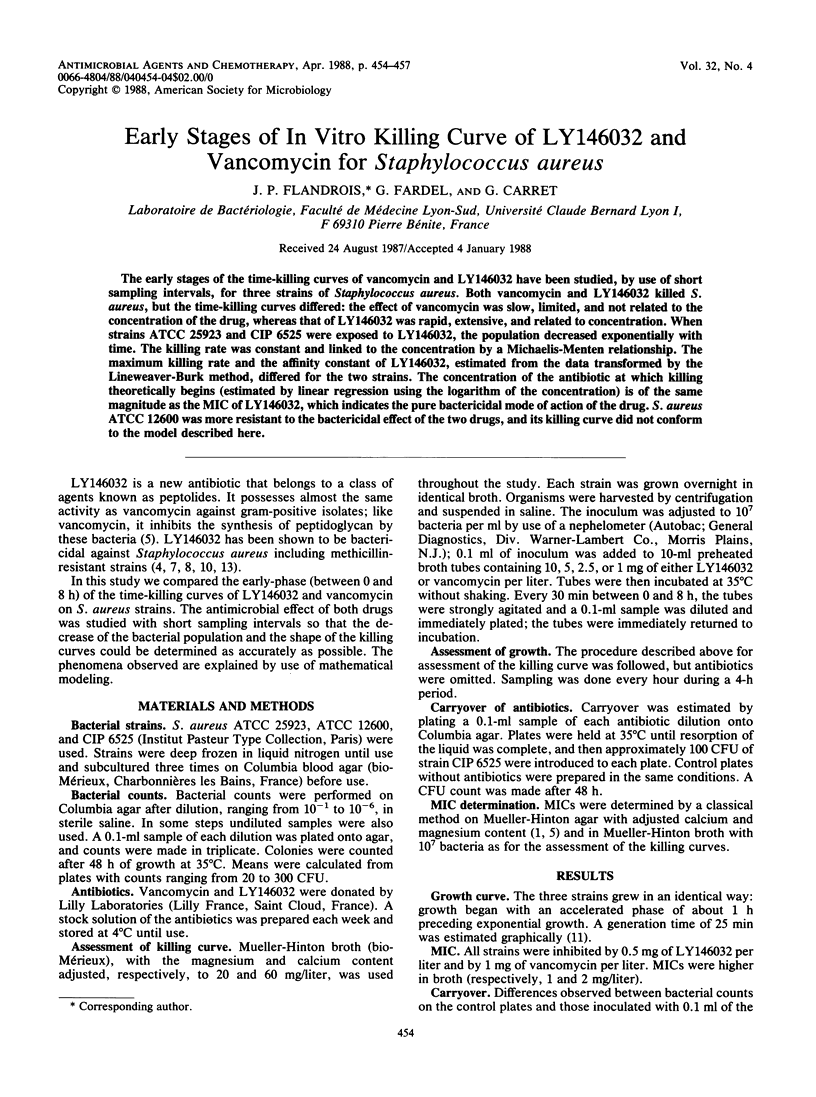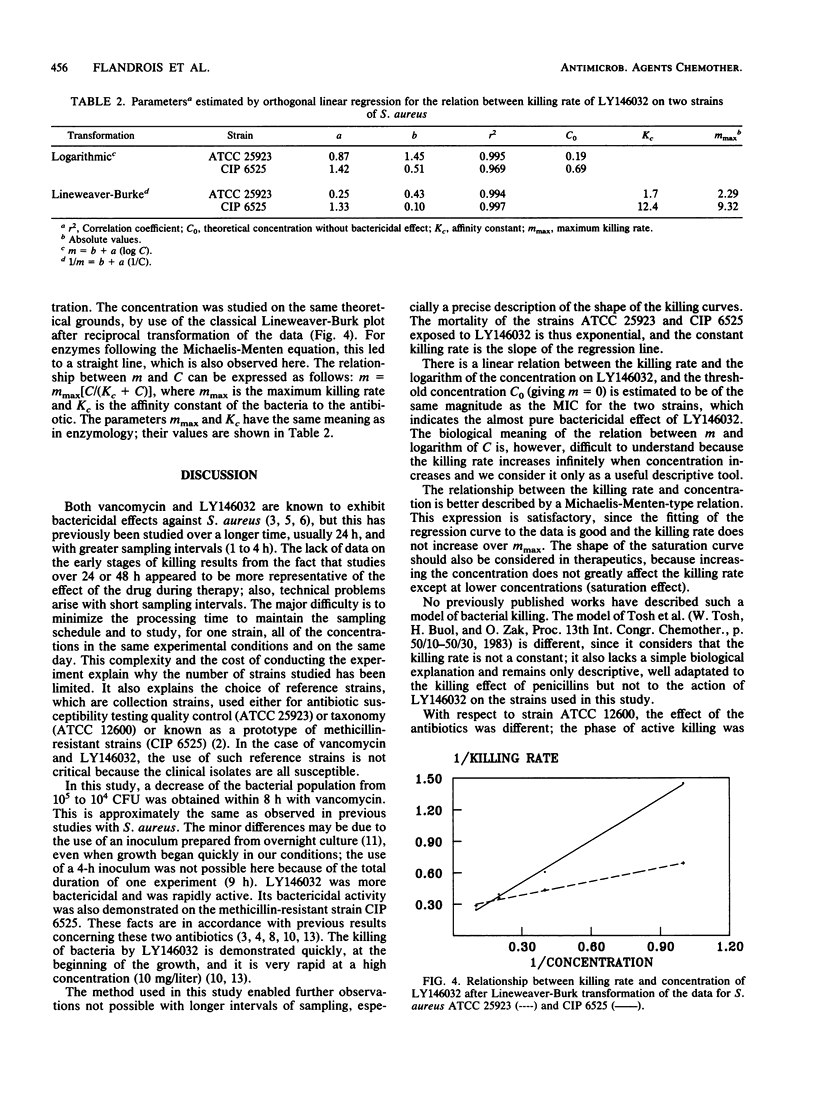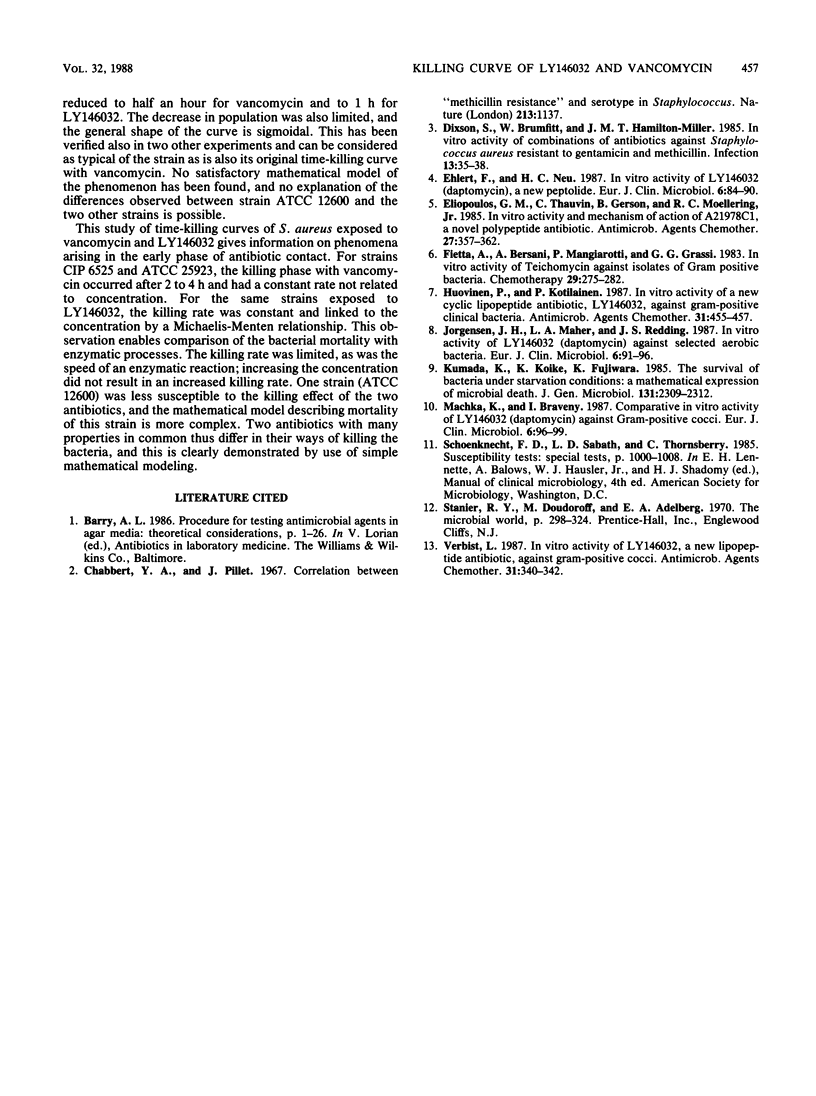Abstract
The early stages of the time-killing curves of vancomycin and LY146032 have been studied, by use of short sampling intervals, for three strains of Staphylococcus aureus. Both vancomycin and LY146032 killed S. aureus, but the time-killing curves differed: the effect of vancomycin was slow, limited, and not related to the concentration of the drug, whereas that of LY146032 was rapid, extensive, and related to concentration. When strains ATCC 25923 and CIP 6525 were exposed to LY146032, the population decreased exponentially with time. The killing rate was constant and linked to the concentration by a Michaelis-Menten relationship. The maximum killing rate and the affinity constant of LY146032, estimated from the data transformed by the Lineweaver-Burk method, differed for the two strains. The concentration of the antibiotic at which killing theoretically begins (estimated by linear regression using the logarithm of the concentration) is of the same magnitude as the MIC of LY146032, which indicates the pure bactericidal mode of action of the drug. S. aureus ATCC 12600 was more resistant to the bactericidal effect of the two drugs, and its killing curve did not conform to the model described here.
Full text
PDF



Selected References
These references are in PubMed. This may not be the complete list of references from this article.
- Chabbert Y. A., Pillet J. Correlation between "methicillin resistance" and serotype in Staphylococcus. Nature. 1967 Mar 18;213(5081):1137–1137. doi: 10.1038/2131137a0. [DOI] [PubMed] [Google Scholar]
- Dixson S., Brumfitt W., Hamilton-Miller J. M. In vitro activity of combinations of antibiotics against Staphylococcus aureus resistant to gentamicin and methicillin. Infection. 1985 Jan-Feb;13(1):35–38. doi: 10.1007/BF01643619. [DOI] [PubMed] [Google Scholar]
- Ehlert F., Neu H. C. In vitro activity of LY146032 (daptomycin), a new peptolide. Eur J Clin Microbiol. 1987 Feb;6(1):84–90. doi: 10.1007/BF02097208. [DOI] [PubMed] [Google Scholar]
- Eliopoulos G. M., Thauvin C., Gerson B., Moellering R. C., Jr In vitro activity and mechanism of action of A21978C1, a novel cyclic lipopeptide antibiotic. Antimicrob Agents Chemother. 1985 Mar;27(3):357–362. doi: 10.1128/aac.27.3.357. [DOI] [PMC free article] [PubMed] [Google Scholar]
- Fietta A., Bersani C., Mangiarotti P., Gialdroni Grassi G. In vitro activity of teichomycin against isolates of gram-positive bacteria. Chemotherapy. 1983;29(4):275–282. doi: 10.1159/000238209. [DOI] [PubMed] [Google Scholar]
- Huovinen P., Kotilainen P. In vitro activity of a new cyclic lipopeptide antibiotic, LY146032, against gram-positive clinical bacteria. Antimicrob Agents Chemother. 1987 Mar;31(3):455–457. doi: 10.1128/aac.31.3.455. [DOI] [PMC free article] [PubMed] [Google Scholar]
- Jorgensen J. H., Maher L. A., Redding J. S. In vitro activity of LY146032 (daptomycin) against selected aerobic bacteria. Eur J Clin Microbiol. 1987 Feb;6(1):91–96. doi: 10.1007/BF02097209. [DOI] [PubMed] [Google Scholar]
- Machka K., Braveny I. Comparative in vitro activity of LY146032 (daptomycin) against gram-positive cocci. Eur J Clin Microbiol. 1987 Feb;6(1):96–99. doi: 10.1007/BF02097210. [DOI] [PubMed] [Google Scholar]
- Verbist L. In vitro activity of LY146032, a new lipopeptide antibiotic, against gram-positive cocci. Antimicrob Agents Chemother. 1987 Feb;31(2):340–342. doi: 10.1128/aac.31.2.340. [DOI] [PMC free article] [PubMed] [Google Scholar]


